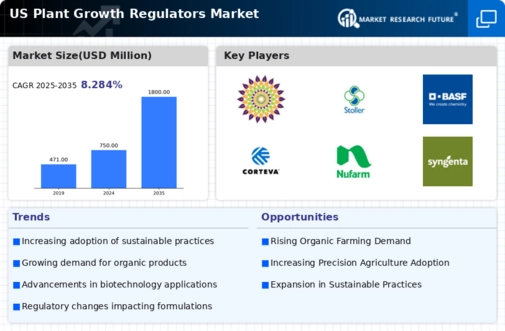The US Plant Growth Regulators Market is characterized by a dynamic and evolving competitive landscape where various players aim to capture significant market share. Plant growth regulators play a pivotal role in enhancing agricultural productivity and facilitating efficient crop management practices. As the demand for these chemical substances continues to rise, companies in the sector are focusing on innovative product development and strategic partnerships to meet the diverse needs of farmers and growers. The competitive insights reveal a trend towards the adoption of sustainable practices, with numerous firms incorporating environmentally friendly solutions into their product lines.
This evolving market is influenced by regulatory frameworks, technological advancements, and shifting consumer preferences towards organic and sustainably sourced agricultural products. The competitive strategies adopted by market players are deeply intertwined with their ability to innovate and respond to market demands effectively.GrowGeneration stands out within the US Plant Growth Regulators Market due to its extensive presence and a strategic approach that focuses on providing a comprehensive range of horticultural products. The company's strengths lie in its formidable distribution network, which caters to a wide customer base, including commercial growers and individual consumers.
GrowGeneration has cultivated a reputation for high-quality products that enhance plant growth and yield, effectively positioning itself as a trusted resource in the agricultural community. The company’s emphasis on customer education and support further reinforces its competitive edge, enabling it to build long-lasting relationships with clients.
By continuously expanding its product offerings and enhancing its retail presence across the United States, GrowGeneration is well-positioned to capitalize on emerging opportunities and maintain a competitive advantage in the plant growth regulators sector.FMC Corporation has also established itself as a key player in the US Plant Growth Regulators Market, offering a diverse range of products that cater to various agricultural needs. The company specializes in producing solutions that include plant growth enhancers and crop protection chemicals, providing farmers with an integrated approach to managing crop health.
FMC Corporation's strengths lie in its robust research and development capabilities, which drive innovation in product formulations and applications. The firm actively engages in key mergers and acquisitions to bolster its market presence and expand its product portfolio, allowing it to respond adeptly to the changes in market demand. Its commitment to sustainability is evident in its focus on creating biopesticides and environmentally friendly growth regulators that minimize harmful impacts on ecosystems. As a leading player, FMC Corporation continues to adapt its strategies to meet consumer expectations, thereby solidifying its position in the competitive plant growth regulators market.




















Leave a Comment